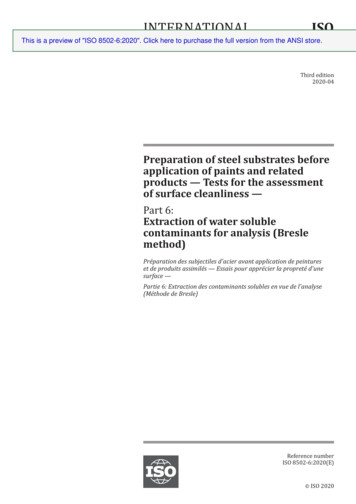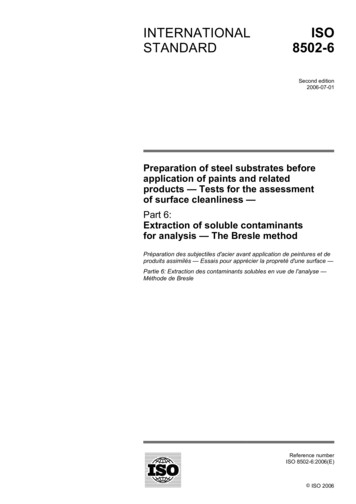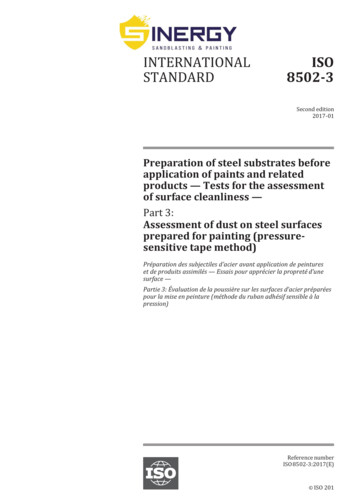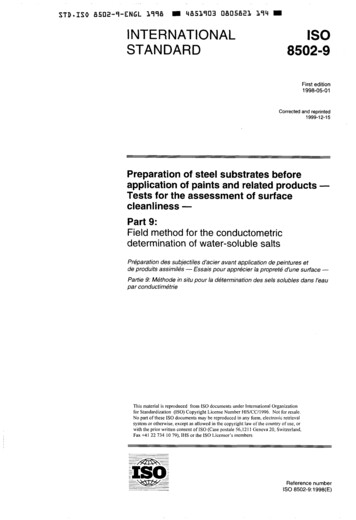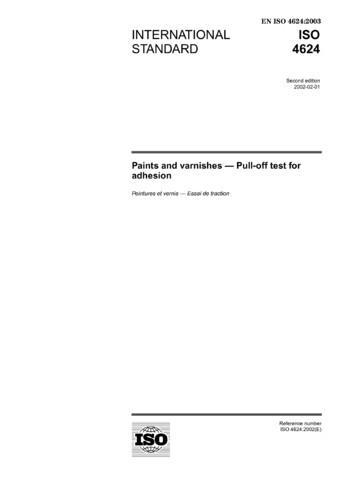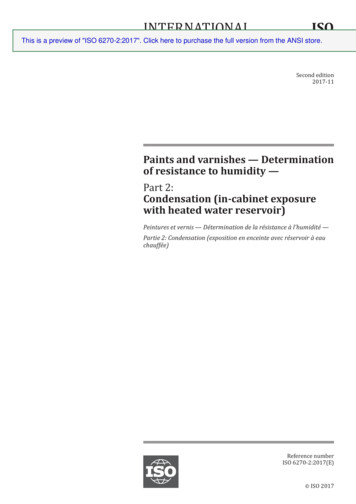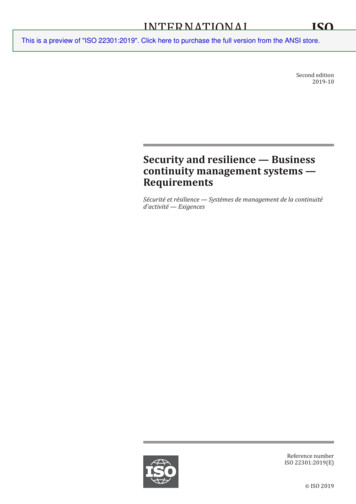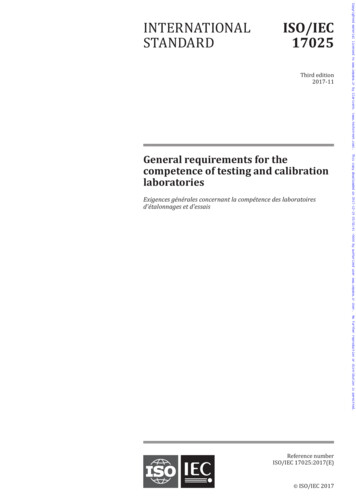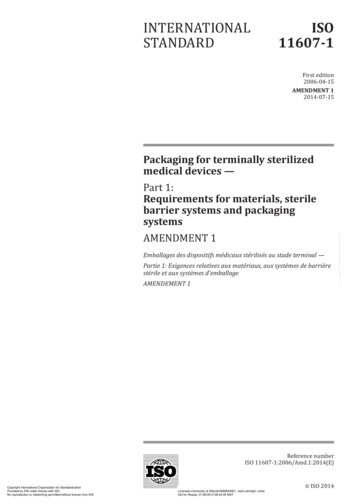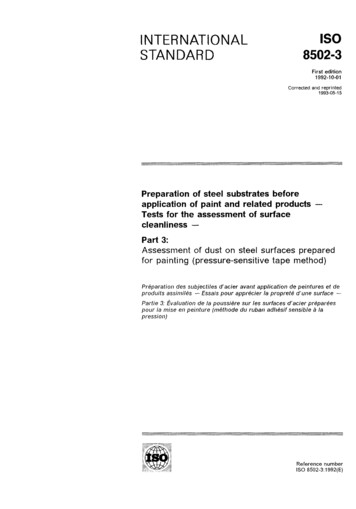
Transcription
INTERNATIONALSTANDARDISO8502-3First edition1992-10-01Corrected and reprinted1993-05-15Preparation of steel substrates beforeapplication of paint and related productsTests for the assessment of surfacecleanlinessPart 3:Assessment of dust on steel surfaces preparedfor painting (pressure-sensitive tape method)Preparation des subjectiles d'acier avant application de peintures et deproduits assimiles - Essais pour apprecier Ia proprete d'une surface Partie 3: Evaluation de Ia poussiere sur les surfaces d'acier prepareespour Ia mise en peinture (methode du ruban adllesif sensible a Iapression)Reference numberISO 8502-3: 1992(E)
IS08502-3:1992(E)ForewordIS0 (the InternationalOrganizationfor Standardization)is a worldwidefederation of national standards bodies (IS0 member bodies). The workof preparing InternationalStandards is normally carried out through IS0technicalcommittees.Each member body interestedin a subject forwhich a technical committee has been establishedhas the right to berepresentedon that committee.Internationalorganizations,governmental and non-governmental,in liaison with ISO, also take part in thework. IS0 collaboratesclosely with the InternationalElectrotechnicalCommission(IEC) on all matters of electrotechnicalstandardization.Draft InternationalStandards adopted by the technical committeesarecirculatedto the member bodies for voting. Publicationas an InternationalStandard requires approval by at least 75 % of the memberbodies casting a vote.InternationalStandard IS0 8502-3 was prepared by Technical CommitteeISO/TC 35, Paints and varnishes, Sub-CommitteeSC 12, Preparationofsteel substrates before application of paints and related products.IS0 8502 consists of the followingparts, under the general titlearation of steel substrates before application of paint and relateducts - Tests for the assessment of surface cleanliness:I: Field test for soluble iron art 2: Laboratory-Part 3: Assessment of dust on steel surfaces prepared(pressure-sensitivetape method)-Part 4: Guidanceon the estimationcondensation prior to paint application-Part 5: Measurementof chloride on steelpainting - Ion detector tube method-Part 6: SamplingBresle methodon surfacesto be painted--Part 7: Analysis of soluble impurities on surfacesAnalysis methods for field use for oil and greaseto be painted-determinationof chlorideof soluble impuritiesofon cleanedthefor paintingprobabilitysurfaces0IS01992All rights reserved. No part of this publication may be reproducedor by any means, electronic or mechanical, including photocopyingpermission in writing from the publisher.surfacespreparedofforor utilized in any formand microfilm, withoutInternationalOrganization for StandardizationCase Postale 56 l CH-1211 Gendve 20 l SwitzerlandPrinted in SwitzerlandCopyright InternationalOrganization for StandardizationiiProvided by IHS under license with ISONo reproduction or networking permitted without license from IHSLicensee University of Alberta/5966844001, User sharabiani, shahramfsNot for Resale, 01/17/2014 00:13:36 MST
IS0-Part 8: Analysis of soluble impuritieson surfacesAnalysis methods for field use for moisture8502-3:1992(E)to be painted-Users should note that the titles to future parts 5 to 8 are working titlesonly and that, while it is at present planned to publish all the parts listedabove, one or more may neverthelessbe deleted from the work programme before publication,which may, in turn, lead to renumberingofthe remaining parts.AnnexCopyright International Organization for StandardizationProvided by IHS under license with ISONo reproduction or networking permitted without license from IHSA of this part of IS0 8502 is for informationonly. .IIILicensee University of Alberta/5966844001, User sharabiani, shahramfsNot for Resale, 01/17/2014 00:13:36 MST
IS08502-3:1992(E)IntroductionThe performanceof protective coatings of paint and related productsapplied to steel is significantlyaffected by the state of the steel surfaceimmediatelyprior to painting. The principal factors that are known toinfluence this performanceare:a) the presenceof rust and mill scale;b) the presencegreases;of surfacec) the surfacecontaminants,includingsalts, dust, oils andprofile.InternationalStandardsIS0 8501, IS0 8502 and IS0 8503 have beenprepared to provide methods of assessing these factors, while IS0 8504provides guidance on the preparationmethods that are availableforcleaning steel substrates, indicating the capabilitiesof each in attainingspecified levels of cleanliness.These InternationalStandards do not contain recommendationsfor theprotective coating systems to be applied to the steel surface. Neither dothey contain recommendationsfor the surface quality requirementsforspecific situationseven though surface quality can have a direct influence on the choice of protective coating to be applied and on its performance.Such recommendationsare found in other documents suchas national standards and codes of practice. It will be necessary for theusers of these InternationalStandardsto ensure that the qualitiesspecified are:-compatibleand appropriate both for the environmentalconditions towhich the steel will be exposed and for the protective coating systemto be used:-withinthe capabilityof the cleaningprocedurespecified.The four InternationalStandards referred to above deal with the following aspects of preparation of steel substrates:IS0 8501 -Visualassessmentof surfaceIS0 8502 - Tests for the assessmentIS0 8503 substrates;SurfaceroughnessIS0 8504 -SurfacepreparationEach of theseparts.ivInternationalCopyright International Organization for StandardizationProvided by IHS under license with ISONo reproduction or networking permitted without license from IHScleanliness;of surfacecharacteristicscleanliness;of blast-cleanedsteelmethods,Standardsis in turndividedinto separateLicensee University of Alberta/5966844001, User sharabiani, shahramfsNot for Resale, 01/17/2014 00:13:36 MST
IS08502-3:1992(E)This part of IS0 8502 describes a procedure for the assessment, usinga pressure-sensitivetape method, of the quantity and the particle sizeof dust on steel surfaces prepared for painting.In the painting schedule requirementsof contractualdocuments givingdetails of surface preparationby blast-cleaning,it is normally specifiedthat all surfaces shall be free from surface contaminationincluding oil,grease, dirt, dust and water-solublesalts.Dust on blast-cleanedsteel surfaces may reduce the adhesion of subsequentlyapplied organic coatings and, by absorbingmoisture, maypromote the corrosion of the blast-cleanedsteel surfaces. Accumulationof dust more naturallyoccurs on horizontalsurfaces, the interior ofpipes, and in structuralcavities. Special inspectionshould be carriedout to ensure that such areas are adequatelycleaned and adequatelyfree from dust before painting.Because of subjectivefactors involved in the test procedure, the testdoes not allow the precise determinationof dust retained on blastcleaned steel surfaces. Nevertheless,when carried out by experiencedoperators,and especiallywhen used to compare the performanceofsurfaces under test with agreed standard specimens, it gives very usefulinformation.There are many possible variables in the conditions at sites where testsmay be required to be carried out. Agreementsmade between interested parties where appropriate should include the number or frequencyof tests, the test locations, and the dates and times when the tests areto be carried out.Copyright International Organization for StandardizationProvided by IHS under license with ISONo reproduction or networking permitted without license from IHSLicensee University of Alberta/5966844001, User sharabiani, shahramfsNot for Resale, 01/17/2014 00:13:36 MST
INTERNATIONALSTANDARDIS08502-3:1992(E)Preparation of steel substrates before application of paint andrelated products - Tests for the assessment of surfacecleanliness Part 3:Assessment of dust on steel surfaces(pressure-sensitivetape method)1Scope1.1This part of IS0 8502 describes a method forthe assessment of dust remaining on cleaned steelsurfaces prepared for painting. It provides pictorialratings for the assessment of the average quantityof dust. It also provides descriptiveclasses for theassessment of the average size of the dust particles.The quantity ratings and size classes referredNOTE 1thispartofIS0 8502arederivedfromtoinIS0 4628-1:1982,Paintsand varnishes- Evaluationofdegradationof paint coatings- Designationof intensity,quantityand size of commontypes of defect-- Part 1:Generalprinciplesand rating schemes.1.2The methodmay be carriedouteithera) as a “pass/fail”test by assessing the quantity ofdust present on a test surface, and the averagedust particle size, in comparisonwith specificlimits;orb) to provide a permanent record of the dust present on a surface by mounting the tapes used tocarry out the tests on tiles, cards or paper, of anappropriatecontrastingcolour.1.3This method is suitable for the assessment ofdust retained,after cleaning,on a steel surfacecorrespondedbeforecleaningtorustwhichgrade A, B or C as defined in IS0 8501-I. BecauseCopyright International Organization for StandardizationProvided by IHS under license with ISONo reproduction or networking permitted without license from IHSpreparedfor paintingof the limited elasticityof adhesive tape, it is notpossible for the tape to penetrate into the deep pitspresentin cleanedsteel that originallycorresponded to rust grade D.1.4While a test procedurein which pressure isapplied to a tape using the thumb is subjective, it isusually adequate,especiallyfor use in situationswhere surfaces free from dust are required. In casesof dispute, except when rust grade C or D is involved, pressure may be applied to the back of theadhesive tape using a spring-loadedroller.2Normative referencesThe followingstandardscontain provisionswhich,through reference in this text, constituteprovisionsof this part of IS0 8502. At the time of publication,the editions indicated were valid. All standards aresubject to revision, and parties to agreements basedon this part of IS0 8502 are encouraged to investigate the possibilityof applying the most recent editions of the standards indicated below. Members ofIEC and IS0 maintainregistersof currentlyvalidInternationalStandards.IS0 8501-I : 1988, Preparationof steel substrates before applicationof paints and related products Visual assessment of surface cleanliness - Part I:Rust grades and preparationgrades of uncoatedsteel substrates and of steel substrates after overallremoval of previous coatings.IEC 454-2:1974, Specificationsadhesive tapes for electricalMethods of test.Licensee University of Alberta/5966844001, User sharabiani, shahramfsNot for Resale, 01/17/2014 00:13:36 MSTfor’pressure-sensitivepurposes - Part2:
IS038502-3:1992(E)DefinitionFor the purposes of this part of IS0 8502, the following definitionapplies.3.1 dust: Loose particulatematter present on asteel surfacepreparedfor painting,arising fromblast-cleaningor other surface preparationprocesses, or resulting from the action of the environment.4PrincipleA pressure-sensitiveadhesive tape is pressed on tothe steel surface prepared for painting. The tape,with the dust adhering to it, is then removed andplaced on a display board of a colour which contrasts to that of the dust, and is examined visually.The quantity of dust adhering to the tape and thedust particle size are then estimated.5Apparatus and materials5.1Adhesivetape, consistingof rolls of suresensitive tape of width 25 mm, having an adhesionpeel strength of at least 190 N per metre width whenmeasuredin accordancewith the 180” peel test inIEC 454-2.NOTE 2This peel test calls for a 180” peelbacking at a peel rate of (300 30) mm/min.fromsteel5.2Displayboard, of colour contrastingto that ofthe dust, for use as a background,e.g. of glass orblack or white glazed tiles, cards or paper.5.3Spring-loadedroller, so designed that it is capable of applying a load of 39,2 N or 49,0 N or anintermediateload. (See annex A.)NOTE 3The roller is calibrated using weightpieces ofmass 4 kg and 5 kg. At the 4 kg calibration point, the forceexertedby the rollerpoint it is 49,0 N.5.4Handlens,is 39,2 N, and at the 5 kg calibrationcapableof magnification6.2 Touching the adhesive side of the tape only atthe ends, press about 150 mm of the freshly exposedtape firmly on to the surface under test. With dueregard to subclause1.4, adopt one of the followingalternativemethods given in a) and b).4 Place the thumb across one end of the tape andmove the thumb, while maintaininga firm pressure, at a constant speed along the tape threetimes in each direction, so that each stroke takesbetween 5 and 6 seconds. Remove the tape fromthe test surface, place it on an appropriatedisplay board (5.2) and cause it to adhere to theboard by rubbing with the thumb.b) Applythe calibratedspring-loadedroller (5.3)centrallyacross one end of the tape and movethe roller, while maintaininga downwardloadbetween 39,2 N and 49,0 N (see note3), at aconstant speed along the tape three times ineach direction,so that each stroke takes between 5 and 6 seconds. Remove the tape fromthe test surface, place it on an appropriatedisplay board (5.2) and cause it to adhere to theboard by rubbing with the thumb.6.3 Assess the quantity of dust on the tape bycomparingvisuallyan area of the tape withequivalent-sizedareas of the pictorialreferencesshown in figure 1. Record the rating correspondingto the reference that is the closest match.TheNOTE 4ible if requiredoverallReportanyrating 5, size class 1.asquantity6.4 Assess the predominating dust particle size onthe adhesive tape by reference to table 1 which defines six dust particle size classes, designated 0, 1,2, 3, 4 and 5.x 10.Procedure6.1 At the beginningof each series of tests, remove and discard the first three turns of tape fromthe roll
ISO 8502-3 First edition 1992-10-01 Corrected and reprinted 1993-05-15 Preparation of steel substrates before application of paint and related products Tests for the assessment of surface cleanliness Part 3: Assessment of dust on steel surfaces prepared for painting (pressure-sensitive tape method)File Size: 565KBPage Count: 14
